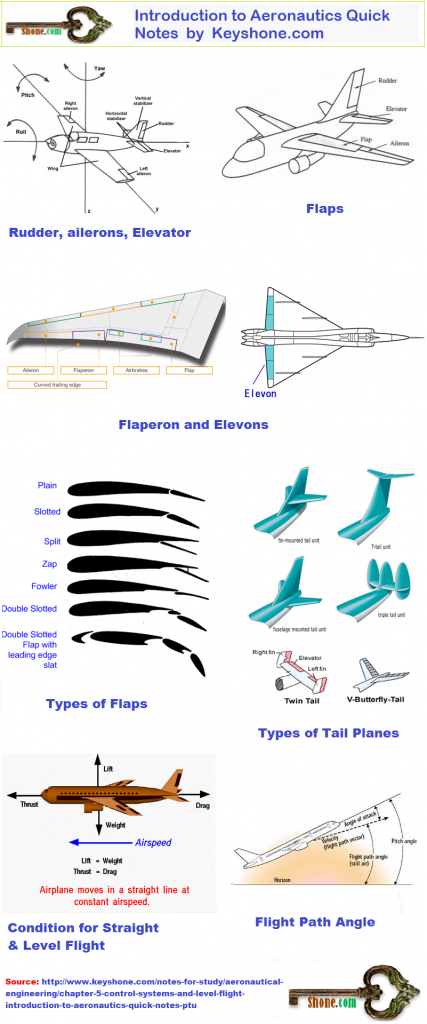Table of Contents
Chapter 5 – Control Systems and Level Flight Introduction to Aeronautics Quick Notes (PTU):-
Various Types of Flaps :-
Flaps are very important part of control systems and level flight.Flaps basically are the hinged surfaces at the trailing and leading edges of main-plane (main wings).These are high lift devices.Flaps are used to increase the lift of aircraft while take-off or landing.This is done by tilting the flaps down which increase the overall camber of wing.As lift is directly proportional to the camber.Hence as camber increases we get more curved surface and ultimately lift increases.This lift helps aircraft to land and take off at low speeds.Short take and landing become possible with the help of such surfaces. Types of flaps are:-
- Plain Flaps
- Slotted Flaps
- Split Flaps
- Zap Flaps
- Fowler Flaps
- Double Slotted Flaps
- Double Slotted Flaps with leading edge slats
Function of Rudder :-
Rudder is also a control surface of aircraft control systems and level flight.It is a hinged surface at trailing edge of vertical tail stabilizer of an aircraft.these are used for Yawing motion of aircraft.Yawing basically is nose left – nose right motion of an aircraft to move in different directions.These surfaces are operated with the help of paddles from inside of cockpit.When pilot presses left paddle, rudder moves to left side.Hence a moment moves aircraft nose to left.When pilot presses right paddle, rudder moves to right side.Hence a moment get generated which moves aircraft nose to right.
You Should Read :-Introduction To Aeronautics Quick Notes and Syllabus (PTU)
Elevator:-
Elevator is one of very important control surface of aircraft control systems and level flight.It is a hinged surface at trailing edge of horizontal tail stabilizer of an aircraft.These are used for pitching motion of aircraft.Pitching basically is nose up – nose down motion of an aircraft to get different angle of attacks .These surfaces are operated with the help of control column or joystick in hand of pilot from inside of cockpit.When pilot pulls column back, elevator moves up.Hence a moment moves aircraft nose up increasing the angle of attack.When pilot pushes column to front, elevator moves down.Hence a moment get generated which moves aircraft nose down.
Ailerons :-
Ailerons are control surface of aircraft control systems and level flight.It is a hinged surface at trailing edge tip-portion of main plane of an aircraft.These are used for rolling motion of aircraft.Rolling basically is aircraft motion about longitudinal axes.These surfaces are operated with the help of control column or joystick in hand of pilot from inside of cockpit.these ailerons moves in alternate direction.When pilot moves column left, one aileron moves up and other moves down.Hence aircraft rolls left and vice -versa.
Flaperons :-
These are special surfaces of control systems and level flight. Flaperons are basically combination of flaps and ailerons.These surfaces itself perform both action weather it is as a flap for getting high lift or as a aileron for rolling.these are on both sides of main planes. Both flaperons can together move up and down or alternately.They are mainly used in Big air-planes and fighter jets with delta wings.
Also See:- Aeronautical Engineering Quick Notes 3rd to 8th Semester (PTU)
Elevons :-
Elevons are also some special kind of control surfaces of aircraft control systems and level flight. It is the combination of elevator and ailerons.These surfaces itself perform both action weather it is as a elevator for getting pitching motion or as a aileron for rolling.these are on both sides of main planes. Both elevons can together move up and down or alternately.They are mainly used in fighter jets with delta wings.
Types of Tail Planes:-
Tail planes also make important role for control systems and level flight of aircraft.Tail planes are categorized on the bases of positions of horizontal and vertical stabilizer.Types of tail planes are:-
- Fuselage mounted tail
- T tail
- Fin-mounted tail
- Twin tail
- Triple tail
- V-Butterfly-tail
You Should read:- Chapter 3 – Airplane Propulsion Introduction to Aeronautics Quick Notes (PTU)
Condition for Straight & Level flight:-
One very important relation of control systems and level flight is a condition straight and level flight.for Different kinds of forces acts on aircraft when it starts moving on grounds with the help of airplane propulsion system. There are basic four fundamental forces acts on aircraft in moving condition.
- Thrust
- Lift
- Drag
- Weight
Thrust is the major force produced by airplane propulsion system i.e. aircraft engines. This forces is used to propel aircraft in forward direction. When aircraft engines throw mass of air or exhaust in backward direction with some force, according to newton’s 3rd law a force with same magnitude propel aircraft in opposite direction. This is thrust force. When aircraft moves forward, aerodynamic forces acts on aircraft. These aerodynamic forces are lift and drag. Lift helps aircraft to fly in air and it acts vertically upward. Drag tries to stop forward motion of aircraft. It acts horizontally in opposite direction to thrust. Weight is force due to gravitational pull of earth and is vertically downwards.
At level flight,Relation between these forces occur.
Lift L = W Weight
Thrust T = D Drag
This is called condition for control systems and level flight.
Also See:- Chapter 2 – Space Vehicles Introduction to Aeronautics Quick Notes (PTU)
Flight Path Angle :-
Flight path angle is the angle between path of free stream striking in front of aircraft and ground or horizon.It is different from that of angle of attack.Angle of attack is angle between chord line of aircraft and path of free stream.


